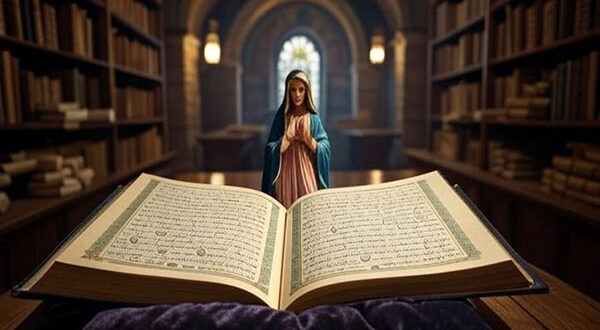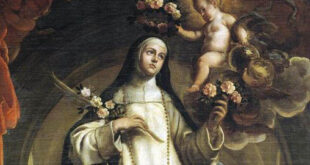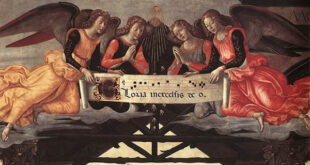A spiritual bridge between Christians and Muslims still waiting to be crossed
Introduction
In a world marked by religious, cultural, and social divisions, the figure of the Virgin Mary emerges as a shining point of unity, reverence, and love. Though deeply venerated by Christians as the Mother of God, what many ignore—even within the Muslim world itself—is that Mary also holds a singular and revered place in the Qur’an, the sacred book of Islam. However, this Qur’anic image of Mary is often partial, incomplete, or even unknown to many Muslims. On the other hand, many Christians are unaware of how much Marian respect is contained in Islam.
This article aims to explore, from a traditional Catholic perspective, the mentions and teachings about Mary in the Qur’an, while also highlighting the theological keys that reveal her true role in the plan of salvation. Through an educational, pastoral, and spiritual journey, we will discover how Mary can become a bridge of dialogue—but also of evangelization and conversion of hearts.
1. Mary in Islam: between honor and omission
a) A woman mentioned by name
The Qur’an, unlike many sacred texts of the non-Christian world, explicitly names Mary (Maryam, in Arabic). In fact, she is the only woman mentioned by name in the entire Qur’an, which in itself is an impressive fact. She is mentioned in 34 verses spread across several suras (chapters). There is even an entire sura named after her: Sura 19: Maryam.
b) Mother of a prophet, not of God
For Islam, Jesus (Isa) is not God nor the Son of God, but rather an extraordinary prophet, miraculously born of Mary without male intervention. The Qur’an states:
“And mention, [O Muhammad], in the Book [the story of] Mary, when she withdrew from her family to a place toward the east.” (Sura 19:16)
And further:
“And We sent to her Our Spirit, and he appeared before her as a well-proportioned man. She said, ‘Indeed, I seek refuge in the Most Merciful from you, [so leave me], if you should be fearing of Allah.’ He said, ‘I am only the messenger of your Lord to give you [news of] a pure boy.’” (Sura 19:17–19)
Thus, the Qur’an acknowledges Mary’s virginity, her purity, and the miracle of Jesus’ conception. However, what is lacking—and essential from the Catholic faith—is the Christological dimension: Mary’s divine motherhood.
2. What many Muslims don’t know about Mary in the Qur’an
a) The title “Mother of the Word” does not appear
Although the Qur’an recognizes the virginal conception, it omits the essential truth of the Word made flesh. In the Gospel, the angel Gabriel says to Mary:
“The Holy Spirit will come upon you, and the power of the Most High will overshadow you; therefore the child to be born will be called holy, the Son of God.” (Luke 1:35)
Islam, by rejecting the divinity of Jesus, deprives Mary of the title of Theotokos (Mother of God), which was solemnly proclaimed at the Council of Ephesus in the year 431. Thus, while Mary is exalted as pure, chosen, and a virgin mother, she is not recognized as a mediator nor as Mother of the Church, as the Catholic faith teaches.
b) Mary, yes—but without the Cross or redemption
One of the great silences of the Qur’an is the Cross. Islam denies that Jesus died crucified, saying instead that “it was made to appear to them so” (Sura 4:157). This denial deprives Mary of the redemptive sorrow she experienced at the foot of the Cross. For Catholics, Mary is not only the Virgin of the Nativity, but also the Sorrowful Virgin, intimately associated with the Passion of Christ, just as Simeon had prophesied:
“And a sword will pierce through your own soul also.” (Luke 2:35)
Many Muslims do not know this dimension of Mary: her co-redemptive role, her faithfulness on Calvary, her union with the saving work of her Son.
3. Mary: a doorway for evangelizing the Muslim world
a) Why is Mary a bridge?
Because she is a figure respected and venerated in both religions. For Muslims, Mary is a model of chastity, obedience, and faith. For Christians, she is Mother, Queen, and model of holiness. This convergence can be a starting point to present the Christian faith without confrontation, from a place of shared admiration.
“Blessed is she who believed that there would be a fulfillment of what was spoken to her from the Lord.” (Luke 1:45)
This faith of Mary, which Islam recognizes as admirable, can be the beginning of showing what it was she truly believed: the mystery of the incarnate God.
b) A concrete pastoral tool
Many Catholic missionaries working in Muslim contexts know this: Mary opens hearts. Some practical suggestions:
- Use images of Mary that reflect tenderness and humility.
- Pray the Rosary as a path of contemplation, even with Muslims open to dialogue.
- Explain Mary’s role in the Bible and how her life was completely united to that of Christ.
- Encourage pilgrimages to Marian shrines, such as Lourdes or Fatima, where even Muslims have had conversion experiences.
4. Theological perspective: Mary as model of the believing soul
In Catholic theology, Mary is not just a historical character, but an archetypal model of the believing soul. As Saint Louis-Marie Grignion de Montfort teaches: “God wishes to make Mary better known, loved and glorified than ever before.” In Mary, every soul can find the path to Christ.
Islam admires Mary, but contemplates her from a limited horizon: it sees her as a holy woman, without grasping her dimension as the New Eve, who, alongside the New Adam, participates in the restoration of the fallen world.
5. A call for today: What can the modern Christian learn?
a) From Mary, we learn the fruitful silence
In a world of noise, Mary teaches us to keep and ponder things in the heart (cf. Luke 2:19). This contemplative attitude is the foundation of mature faith. Even in encounters with Muslims, it is often the witness of life, more than doctrinal argument, that opens doors.
b) From Muslims, we learn respect for the sacred
Although their view is incomplete, Islam shows deep reverence for Mary. This respect can inspire Christians themselves to rediscover with greater fervor the place of the Virgin in their spiritual life, since many modern Catholics have relegated Mary to a secondary role.
Conclusion: Mary, Mother of all peoples
The Virgin Mary is more than a symbol of unity: she is a real, living, and active mother, who intercedes for all her children, including those who do not yet fully know her Son. Her figure, respected in Islam, can be the key that opens Muslim hearts to the fullness of truth.
The Virgin continues to say:
“Do whatever He tells you.” (John 2:5)
This “He” is not a mere prophet, but the Word made flesh. The pastoral and spiritual challenge of our time is to tenderly, patiently, and truthfully show who Jesus really is, beginning often with the one who knows Him best: His mother.
Final Prayer
Holy Mary, Mother of God,
open the hearts of our Muslim brothers and sisters to the light of your Son.
You, who were announced by Gabriel in both the Qur’an and the Gospel,
guide us all along the path of truth and life.
Amen.






